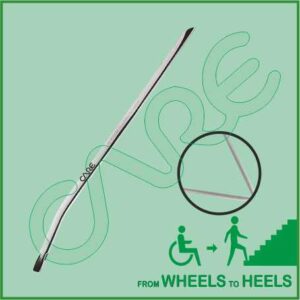Description
DAKSH Multi Tibia Nail Specification
Versatile proximal locking options in Expert Tibia Nail
- Versatile proximal locking options. Three unique and innovative locking options, in combination with cancellous bone locking screws, increase the stability of the proximal fragment for proximal third fractures.
- Two state of the art medio-lateral (ML) locking options enable primary compression or secondary controlled dynamization.
End caps
- Securely lock the most proximal oblique locking screw to create a fixed-angle construct
- End cap prevents ingrowth of tissue and facilitates nail extraction
- Self-retaining Screw Driver recess for effortless end cap pick-up and ease of insertion
- 0mm end cap sits flush with nail
- 5, 10 and 15mm end caps extend nail height if nail is over inserted Cannulated
Advanced nail design
- New anatomic bend for ease of insertion
- Titanium alloy for improved mechanical and fatigue properties
- Cannulated nails (from Ø 8mm to Ø 13mm) for reamed or unreamed techniques, enabling nail insertion over guide wire
- 2.5mm or 3mm ball tipped guide wires may be removed through the nail and insertion handle assembly (no exchange tube required).
- Solid nails (from Ø 8mm to Ø10 mm) for unreamed technique
Advanced distal locking options in DAKSH Multi Tibia Nail
- Distal oblique locking option to prevent soft tissue damage and increase stability of the distal fragment
- Two ML and one antero-posterior (AP) locking options for stability of the distal fragment
All locking screws
- Double lead thread for more contact points for enhanced stability and ease of insertion
- Thread closer to screw head providing better bone purchase in the near cortex and improved stability
- Titanium alloy for improved mechanical and fatigue properties
- Self-tapping blunt tip
- Self-retaining Screw Driver recess allows improved torque transmission and increased resistance to stripping relative to a hex recess and secure locking screw pick-up.
Cancellous bone locking screws
- Indicated for the three unique proximal locking options of all tibia nails diameters
- Dual core design for optimized purchase in cancellous bone
- Unicortical
DAKSH Multi Tibia Nail Uses
DAKSH Multi Tibia Nail is indicated for fractures in the tibial shaft as well as for metaphyseal and certain intraarticular fractures of the tibial head and the pilon tibiale.
Case 1: Fracture involving the proximal component
The use of the three locking screws in the proximal oblique locking options ensures optimal stabilization of the proximal fragment. The distal segment can be stabilized by using two ML locking options. Stability of the distal fragment can be enhanced by the use of a third locking screw in the AP hole.
Case 2: Shaft fracture
For simple shaft fractures, two proximal ML and two distal ML locking screws are normally sufficient to stabilize the fracture. Secondary dynaminization is achieved by removing the proximal static locking screw.
Case 3: Fracture involving the distal component
The use of four distal locking screws in DAKSH Multi Tibia Nail is sometimes necessary to achieve stabilization of the distal fragment. In many cases though, three locking screws placed in the most distal locking options are sufficient to stabilize the distal fragment.
Expert Tibia Nail Contraindications
The physician’s education, training and professional judgement must be relied upon to choose the most appropriate device and treatment. Conditions presenting an increased risk of failure include:
- Any active or suspected latent infection or marked local inflammation in or about the affected area.
- Compromised vascularity that would inhibit adequate blood supply to the fracture or the operative site.
- Bone stock compromised by disease, infection or prior implantation that can not provide adequate support and/or fixation of the devices.
- Material sensitivity, documented or suspected.
- Obesity. An overweight or obese patient can produce loads on the implant that can lead to failure of the fixation of the device or to
failure of the device itself. - Patients having inadequate tissue coverage over the operative site.
- Implant utilization that would interfere with anatomical structures or physiological performance.
- Any mental or neuro muscular disorder which would create an unacceptable risk of fixation failure or complications in postoperative care.
- Other medical or surgical conditions which would preclude the potential benefit of surgery.
 CARE IMPLANTS & INSTRUMENTS
CARE IMPLANTS & INSTRUMENTS





